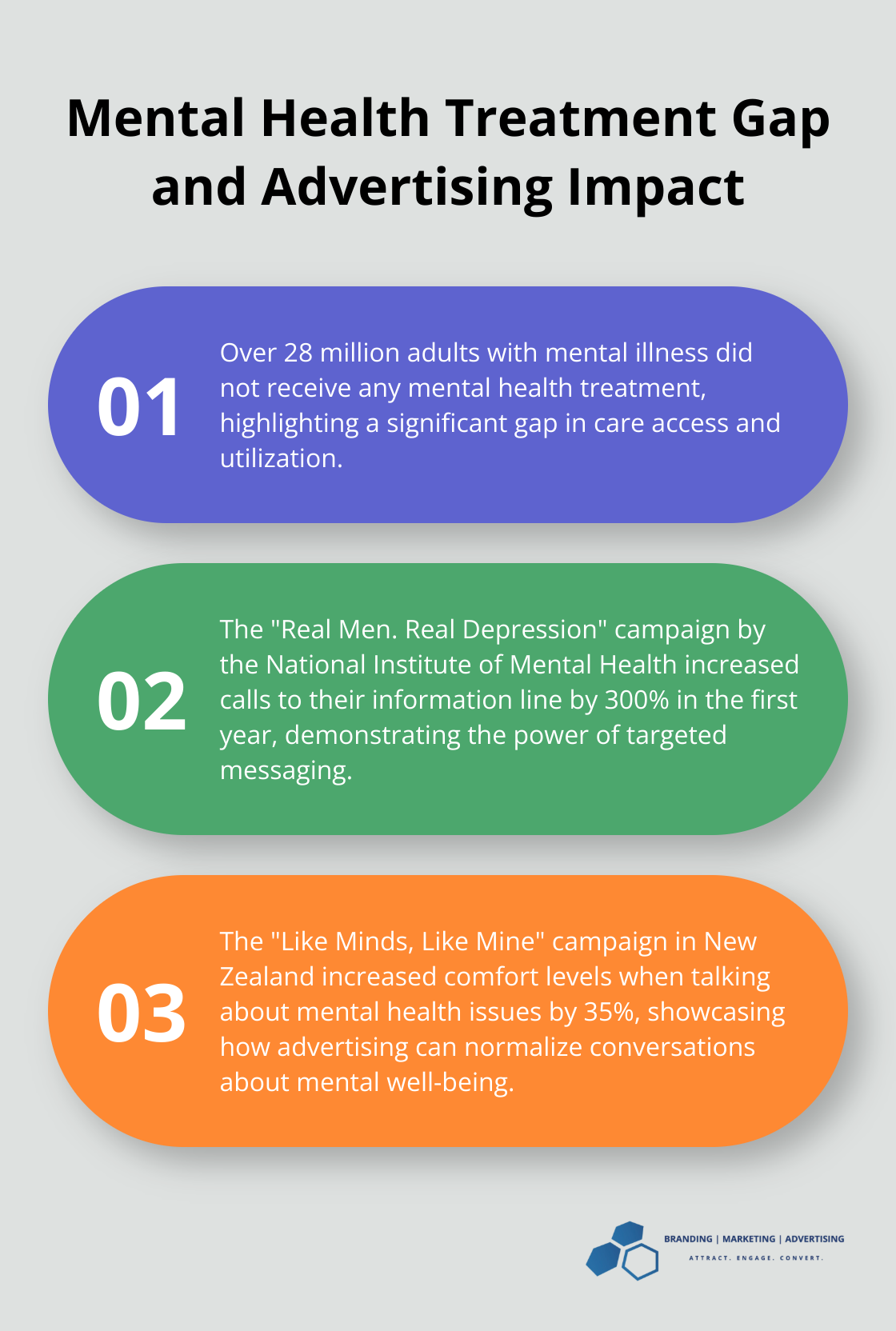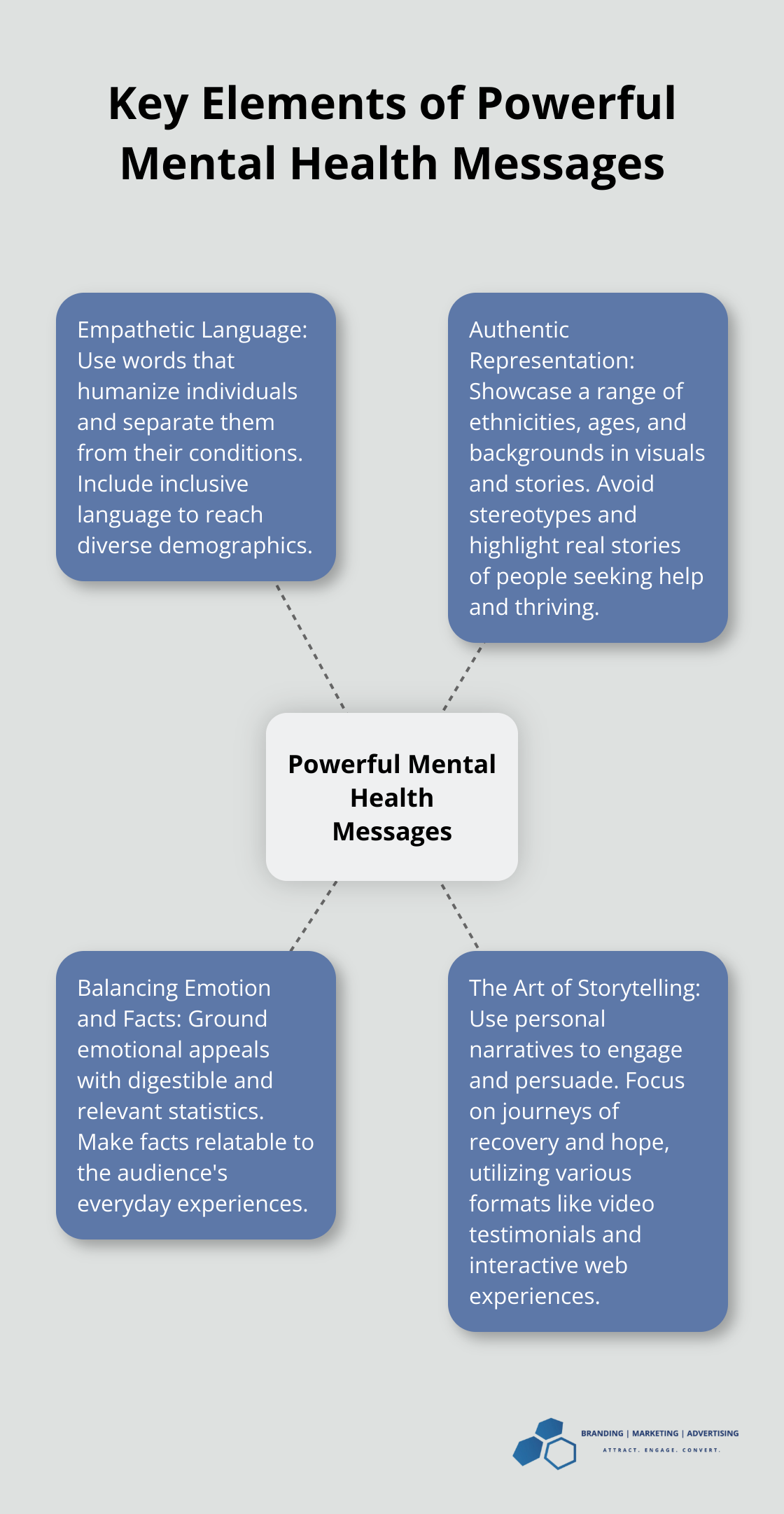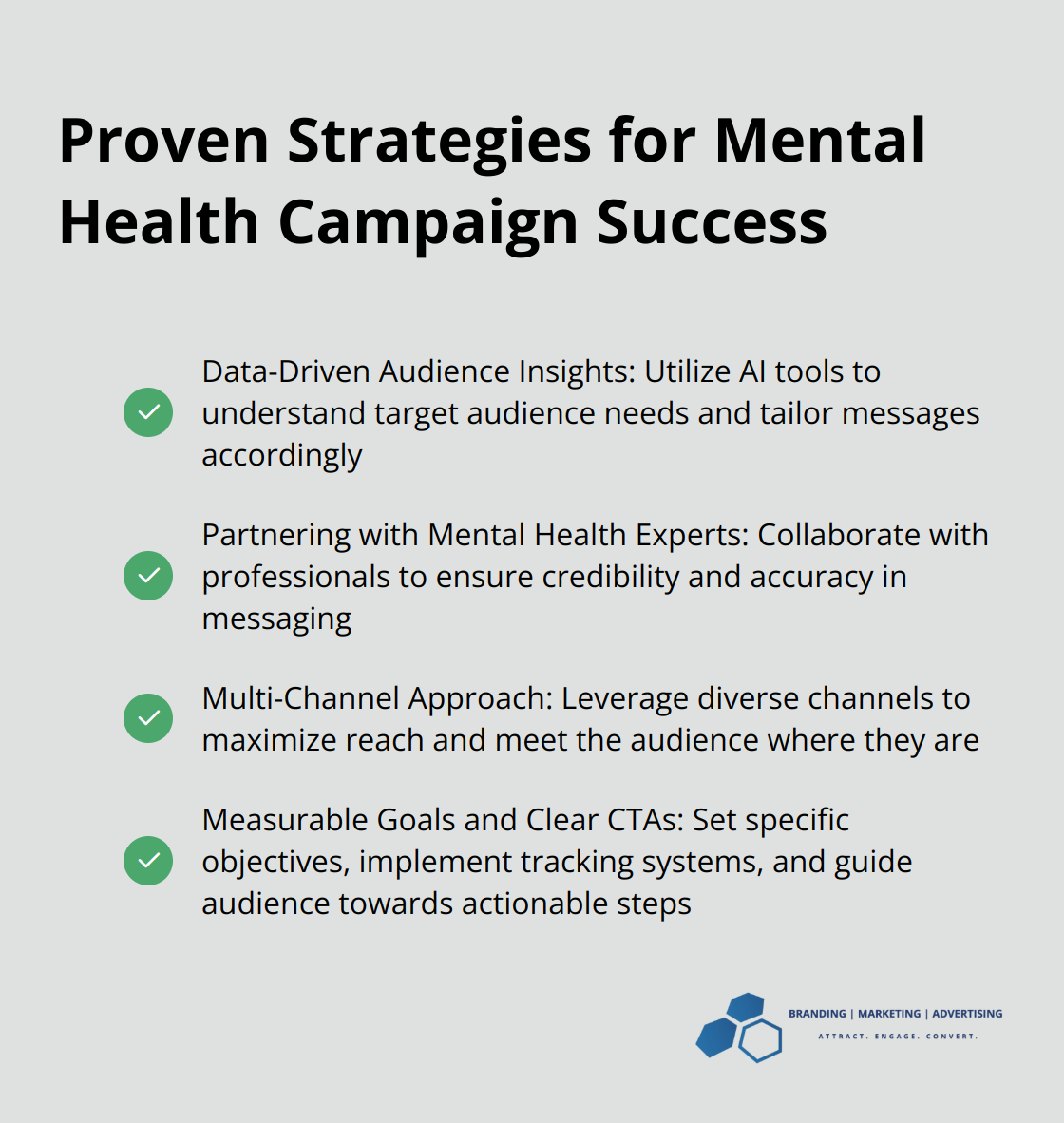How to Create Impactful Mental Health Advertising
Mental health advertising plays a vital role in breaking down stigma and promoting well-being. At Branding | Marketing | Advertising, we’ve seen firsthand how creative mental health ads can make a significant impact on society.
This blog post will guide you through the process of crafting compelling campaigns that resonate with audiences and drive positive change. We’ll explore key strategies, best practices, and innovative approaches to create mental health advertising that truly makes a difference.
Why Mental Health Advertising Matters
Mental health advertising serves as a powerful catalyst for social change. Let’s explore the critical role these campaigns play in shaping public perception and driving action.
Breaking Down Barriers
Mental health stigma remains a significant obstacle. Over 28 million adults with mental illness did not receive any mental health treatment. Effective advertising chips away at this stigma. The “Time to Change” campaign in the UK (a notable success story) aimed to reduce stigma and discrimination against people with depression.

Encouraging Help-Seeking
Well-designed ads motivate people to seek help. The “Real Men. Real Depression” campaign by the National Institute of Mental Health increased calls to their information line by 300% in the first year. This demonstrates how targeted messaging drives tangible results.
Spotlight on Resources
Many people lack awareness of available mental health resources. A survey by the American Psychological Association found that 30% of adults don’t know how to access mental health care. Advertising plays a vital role in bridging this knowledge gap. Crisis Text Line (a mental health support service) saw a 116% increase in usage after launching a targeted ad campaign.
Normalizing Conversations
Mental health advertising helps normalize discussions about mental well-being. The “Like Minds, Like Mine” campaign in New Zealand increased comfort levels when talking about mental health issues by 35%. This openness proves vital for early intervention and support.
These insights highlight the transformative power of mental health advertising. It’s not just about raising awareness – it’s about driving real change in how society views and addresses mental health. The next section will explore the key elements that make these campaigns truly impactful.
Creating valuable content is essential for any mental health campaign. Similarly, social marketing strategies can significantly boost the reach of mental health resources online. Effective healthcare social media marketing plays a crucial role in spreading mental health awareness.
Crafting Powerful Mental Health Messages
At Branding | Marketing | Advertising, we understand that creating impactful mental health advertising requires a delicate balance of empathy, authenticity, and strategic communication. Let’s explore the key elements that make mental health campaigns truly resonate with audiences.

The Power of Empathetic Language
Words matter, especially when addressing sensitive topics like mental health. The Power of Empathetic Language is crucial in addressing mental health stigma, its origins, manifestations, and potential solutions. This approach humanizes individuals and separates them from their conditions.
Inclusive language also plays a vital role. The Trevor Project found that LGBTQ+ youth who had access to spaces that affirmed their sexual orientation and gender identity reported lower rates of attempting suicide. When crafting your message, consider how different demographics might interpret your words.
Authentic Representation Matters
Diversity in mental health advertising isn’t just about ticking boxes – it reflects the real world. A study by the Substance Abuse and Mental Health Services Administration (SAMHSA) showed that culturally competent mental health services improved outcomes for minority populations. Apply this principle to your advertising by showcasing a range of ethnicities, ages, and backgrounds in your visuals and stories.
Authenticity also means avoiding stereotypes. The “strong silent type” trope, for example, can harm men’s mental health messaging. Instead, highlight real stories of men seeking help and thriving. This approach normalizes help-seeking behavior across all demographics.
Balancing Emotion and Facts
While emotional appeals can be powerful, facts must ground them to be truly effective. The “Seize the Awkward” campaign, a partnership between JED and AFSP, targets young adults aged 18-24, encouraging them to engage in conversations about mental health.
When presenting statistics, make them digestible and relevant. For instance, instead of saying “1 in 5 adults experience mental illness,” you could say “In a typical office of 100 people, 20 might silently struggle with their mental health.” This framing makes the issue more tangible and relatable.
The Art of Storytelling
Narratives have a unique power to engage and persuade. The “Time to Change” campaign in the UK used personal stories to great effect, contributing to a 9.6% improvement in attitudes towards people with mental health problems. When crafting your stories, focus on journeys of recovery and hope rather than dwelling solely on struggles.
Consider using a variety of storytelling formats. Video testimonials, social media series, and even interactive web experiences can all effectively share mental health narratives. The key is to create content that feels authentic and relatable to your target audience.
These elements form the foundation of impactful mental health advertising. The next section will explore strategies to implement these concepts in your campaigns, ensuring your message reaches and resonates with your intended audience.
Proven Strategies for Mental Health Campaign Success
At Branding | Marketing | Advertising, we have developed a set of powerful strategies to create mental health campaigns that truly resonate. Our approach combines thorough research, expert collaboration, and strategic implementation to drive meaningful impact.

Data-Driven Audience Insights
Understanding your target audience is essential. AI tools can provide valuable insights into how your target market seeks and engages with mental health services. By analyzing data on search queries and website interactions, we can tailor messages that speak directly to the needs and concerns of specific groups.
A campaign targeting college students might focus on stress management and academic pressure. In contrast, a campaign for working professionals could address burnout and work-life balance.
Partnering with Mental Health Experts
Collaboration with mental health professionals adds credibility and ensures accuracy in your campaigns. We work closely with psychologists, therapists, and advocacy groups to develop messaging that’s both impactful and scientifically sound.
Multi-Channel Approach for Maximum Reach
To maximize impact, we leverage a diverse mix of channels. This might include social media, traditional advertising, community events, and partnerships with influencers or organizations. The key is to meet your audience where they are.
Measurable Goals and Clear Calls-to-Action
Every successful campaign needs clear, measurable objectives. We set specific, time-bound goals and implement robust tracking systems to measure progress. This might include metrics like website visits, hotline calls, or appointment bookings.
Equally important are clear calls-to-action (CTAs). Whether it’s encouraging people to seek help, share their stories, or support a cause, every piece of content should guide the audience towards a specific action.
These strategies create mental health campaigns that don’t just raise awareness – they drive real change. Our approach combines empathy with data-driven insights, ensuring your message reaches and resonates with those who need it most.
Final Thoughts
Creative mental health ads transform lives and drive social change. They break down stigma, encourage help-seeking, and normalize conversations about mental well-being. Well-executed campaigns lead to tangible results, such as increased support line calls and improved attitudes towards those facing mental health challenges.
Data-driven strategies, expert collaboration, and multi-channel approaches create successful mental health campaigns. Clear goals, robust tracking systems, and actionable next steps ensure efforts drive meaningful change. The ongoing need for mental health advertising remains critical as society grapples with the complexities of mental well-being.
We urge businesses, organizations, and individuals to invest in mental health advertising. Together, we can create a world where mental health receives priority, understanding, and support. If you want to make a difference through impactful mental health campaigns, we’re here to help you succeed.












